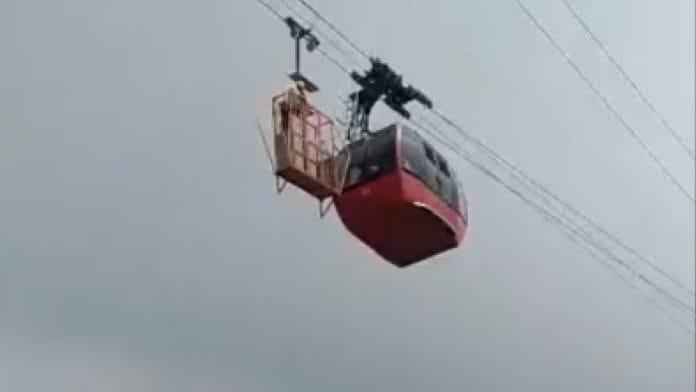New Delhi: On Monday, 11 tourists enjoying a ride on the famous cable car of the Timber Trail resort in Himachal Pradesh got stuck mid-air 1,500 feet above the ground, reportedly due to a technical snag. All were rescued by 5 pm that day — but this isn’t the first time this cable car has come to a halt mid-journey, leaving tourists hanging mid-air between two hilltops.
In a now-fabled incident from 1992, a rescue operation by the Army — in particular, the heroics of one Colonel Ivan Joseph Crasto (Retd), then a major — and the Indian Air Force (IAF) saved 10 lives.
Nestled in the Shivalik Hills, the Timber Trail resort lies just off the highway leading to Kasauli and Shimla in Himachal Pradesh’s Parwanoo town. The resort has long been a a major attraction to visitors passing along the highway because of its famed cable car, which takes tourists from its hilltop to Timber Height, located on another mountaintop, approximately 1.8km from the resort.
On 13 October 1992, Timber Trail’s cable car got stuck mid-air as the haulage cable broke near the docking station. This made the cable car slide backwards and dangle in the air.
The cable car operator jumped out in a desperate attempt to save his life, and died after he hit a rock. The trolley was left suspended 1,500 ft above the Kaushalya River.
All communication between the trolley and the base was also lost as the walkie-talkie system onboard fell out when the trolley slid back.
At about 6 pm on the day, the hotel management contacted the Army brigade at Kasauli for help. The brigade, in turn, contacted the Western Army Command at Chandi Mandir in Haryana, following which the Army swung into action to rescue the tourists.
Also Read: Army commando who rescued Himachal tourists from dangling cable car now teaches Math in Australia
Rescue operation
By evening, a 152-helicopter unit based at Sarsawa in Uttar Pradesh, 1 Para Commando from Nahan in Himachal Pradesh, and a unit of engineers from Chandi Mandir had been called into action.
At dawn on 14 October, the helicopter, commando and engineer units had started the rescue work. Group Captain Fali Homi Major — who later went on to become Chief of the Air Staff — coordinated and supervised the operations, and flew the reconnaisance sorties.
There were three options to rescue the 10 civilians — lower a commando into the trolley and then winch the trapped tourists up by a helicopter; or detach the trolley from the track and the wires, attach it with the hatchet of the helicopter and lift it up; or attach the trolley with another wire and lower it into the valley.
After deliberations, they decided to pursue the first option — and the actions of para commando Crasto would prove central to the mission.
With experience from a training stint in the Soviet Union, the 28-year-old officer reportedly descended onto the roof of the trolley from an Mi-17 helicopter at 5.25 pm, and stood there with apparent nonchalance.
After securing himself, Crasto opened the hatch of the trolley’s roof, explained the winching procedure to the stranded tourists, and decided to evacuate them one by one. As daylight was receding, only four passengers were rescued on the first day. Crasto decided to stay overnight with the remaining tourists to reassure them. “I have two kids at home and the fact that I am staying on means there is nothing to worry,” he was quoted as saying by India Today.
The following morning, the remaining passengers were rescued and brought down to safety by a combined team of the IAF and the Army.
For their actions, Crasto was given the Kirti Chakra, while Fali Major received the Shaurya Chakra. Group Captain P. Upadhyay, who was then flight lieutenant, was awarded the Vayu Sena Medal for his role as Fali Major’s co-pilot.
(Edited by Tony Rai)
Also Read: Quaid Post to Bana Top: How the Indian Army took back a critical post in Siachen 35 years ago






